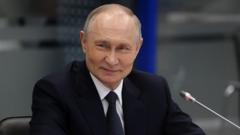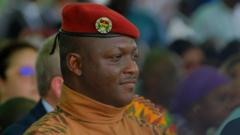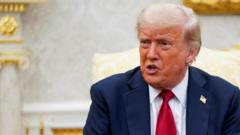Despite the potential for tightened sanctions from the US, Russia's stock market experienced a surprising uptick, indicating a certain level of preparedness and resilience.
US Tariff Threat Sparks Mixed Reactions in Russia Amid Ukraine Conflict

US Tariff Threat Sparks Mixed Reactions in Russia Amid Ukraine Conflict
The recent US tariffs threatened by President Trump have stirred a complex response from Russia, revealing both anxiety and unexpected relief.
Trump's announcement of new arms to Ukraine, directed by European governments, coupled with threats of further tariffs, has raised the stakes in the ongoing Ukraine conflict, yet positioned Russia to strategize responses in the coming 50 days.
In the Oval Office this week, President Donald Trump issued a stern warning, announcing new arms shipments to Ukraine, financed by European nations, and stimulating fears of imminent tariffs targeting Russia's economy amidst its ongoing conflict with Ukraine. However, the immediate reaction from Moscow was one of relief rather than panic, as the Russian stock exchange notably surged by 2.7%. Analysts suggest that this was in part because Russia had anticipated even harsher sanctions and thus welcomed some breathing room with the alternative timeline of 50 days to enact these tariffs.
Russian media, including the tabloid Moskovsky Komsomolets, hinted at the impending confrontation with the US but seemed optimistic that the grace period provided could allow Russia to formulate counter-proposals. The immediate pressure from Trump's warning about sanctions would perhaps prompt more diplomatic maneuvers rather than provoke frantic market reactions.
Trump's challenge to Russia coincides with his administration's longstanding efforts to hold Moscow accountable for its military actions in Ukraine, which have drawn international condemnation. While the US leader aims to push for a resolution to the war—one of his foreign policy cornerstones—the Kremlin has so far been reluctant to capitulate to demands without addressing what it calls its security concerns first.
The conversation surrounding peace negotiations has often been framed by the rhetoric of the Kremlin, insisting that military assistance to Ukraine must cease for true dialogue to commence. The irony remains potent: it was Moscow that initiated a widespread invasion, creating a front that has turned into the largest military conflict in Europe since World War II.
As Trump seeks means to exert pressure on Putin to negotiate, the Russian government continues to wrestle for leverage, seemingly comfortable with its current military stance. With the Kremlin poised to use the upcoming weeks strategically, the dynamics of US-Russia relations remain fraught, characterized by mistrust and an ever-evolving geopolitical landscape.
In the Oval Office this week, President Donald Trump issued a stern warning, announcing new arms shipments to Ukraine, financed by European nations, and stimulating fears of imminent tariffs targeting Russia's economy amidst its ongoing conflict with Ukraine. However, the immediate reaction from Moscow was one of relief rather than panic, as the Russian stock exchange notably surged by 2.7%. Analysts suggest that this was in part because Russia had anticipated even harsher sanctions and thus welcomed some breathing room with the alternative timeline of 50 days to enact these tariffs.
Russian media, including the tabloid Moskovsky Komsomolets, hinted at the impending confrontation with the US but seemed optimistic that the grace period provided could allow Russia to formulate counter-proposals. The immediate pressure from Trump's warning about sanctions would perhaps prompt more diplomatic maneuvers rather than provoke frantic market reactions.
Trump's challenge to Russia coincides with his administration's longstanding efforts to hold Moscow accountable for its military actions in Ukraine, which have drawn international condemnation. While the US leader aims to push for a resolution to the war—one of his foreign policy cornerstones—the Kremlin has so far been reluctant to capitulate to demands without addressing what it calls its security concerns first.
The conversation surrounding peace negotiations has often been framed by the rhetoric of the Kremlin, insisting that military assistance to Ukraine must cease for true dialogue to commence. The irony remains potent: it was Moscow that initiated a widespread invasion, creating a front that has turned into the largest military conflict in Europe since World War II.
As Trump seeks means to exert pressure on Putin to negotiate, the Russian government continues to wrestle for leverage, seemingly comfortable with its current military stance. With the Kremlin poised to use the upcoming weeks strategically, the dynamics of US-Russia relations remain fraught, characterized by mistrust and an ever-evolving geopolitical landscape.




















